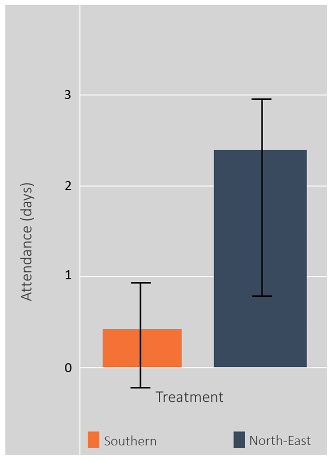Nudging Parents to Improve Preschool Attendance

Context
Preschool is an invaluable opportunity for children to develop cognitive, socio-emotional, and motor skills; but for children to obtain these preschool gains, they must be physically present. Typically, absenteeism rates in the early years are notably higher than at other school levels.
Children who do not regularly attend preschool miss learning opportunities and interrupt their skills acquisition process, which might prevent them from reaching their potential. These children are likely to have lower academic results later and to perform worse in the labor market.
Uruguay has increased preschool coverage levels to reach almost universal education for ages four and five. However, more than one-third of children enrolled in public preschool programs do not attend regularly, and absenteeism is skewed towards schools located in lower socio-economic areas and lower preschool grades.
One major factor contributing to children’s absence from preschool may be that parents do not understand or value the significance of early childhood education. Programs that shift parents’ mindsets by emphasizing the benefits of preschool attendance could be effective in lowering absenteeism rates. To date, little research exists on how to best shift parents’ attitudes regarding the value of early childhood education.
The Project
In partnership with the Ministry of Education, this study evaluates the impact of a behaviorally informed message intervention in Uruguay. The key research question is whether behaviorally informed text messages can “nudge” parents to bring their children to preschool every day, and if these messages change parents’ attitudes toward early education. Text messages were delivered through the Ministry of Education’s “GURI familia” application, a platform for communication between parents and schools. They targeted parents of children from three to five years old enrolled in public preschools.
Behavioral Analysis
Behavioral Barriers
Hassle factors: Seemingly small inconveniences, such as having to read a lot of information or take an extra small step to complete an action, can hinder or disrupt decision-making processes. In this context, even if parents believe they should send their children to school, it takes only a few simple obstacles for them to desist from their intention.
Status quo bias: It is the tendency to maintain the current state of affairs, even when change is clearly better. This current status, or status quo, is used as a reference point, and any change with regard to this reference is seen as a loss. In this context, not sending their children to school every day).
Behavioral Tools
Feedback: It is an effective tool to enhance awareness of the consequences of various choices. It may fill knowledge gaps and foster the search for efficient alternatives.
Framing: The way in which information is presented influences people’s conclusions. For example, options may be presented in a way that highlights their positive or negative aspects, leading each to be perceived as relatively more or less attractive.
Planning tools: These are designed to encourage individuals to make a concrete action plan on important goals, like paying social security. These prompts help individuals to break down a goal (e.g., being on time to a doctor’s appointment) into a series of small, specific tasks (e.g., leaving work early, finding a babysitter, postponing a weekly meeting, etc.) and to anticipate unforeseen events. These prompts often encourage people to write down relevant information such as the date, time, and place of a commitment.
Intervention Design
Parents of students in 194 preschools were assigned to one of two groups:
- Text-message group: These parents received text messages intended to nudge them to bring their children to school consistently and minimize unnecessary absences. The messages focused on providing information about the number of absences to date, the benefits of early childhood education, logistical planning to get children to preschool, and the important role parents play in getting their children to school. Parents received three or four messages weekly for three months. The personalized messages were designed to include four different behavioral science tools to induce parents to change behavior:
Feedback:
“[Parent name], [child’s name] has been absent [# absences] days in the last 3 weeks. Help him develop a habit of responsibility by avoiding missing more days the rest of the year!”
Planning prompt:
“[Parent name]: Think about the reasons that may have prevented your child from attending school last year. Create a plan to avoid them this school year!”
Positive parental identity:
“[Parent name]: What you do for [child’s name] today—for example, taking him/her to school—will impact his/her future. You have a key role in their education!”
Gains in the short and long term:
“Hello [Parent name]: Have you noticed the change in the development of [child’s name] since s/he attends preschool? Imagine what it would be like if s/he went every day. Let the rain not be an excuse, take her/him!”
Messages were sent from three to four times per week, varying the day, and between 5 and 8 p.m.
- Comparison group: Parents assigned to this group did not receive the messages during the intervention period.
Challenges
Timing the intervention to match the season when absenteeism is highest is key as well as context analysis. If absenteeism is related more to psychological barriers than structural factors, nudging may be irrelevant in addressing the underlying problem.
In future interventions addressing older students, messages might be sent to students themselves as well as their parents. Also, an intervention’s effects might intensify after three months of exposure.
Results
This randomized evaluation was effective in increasing students’ attendance in the middle of the distribution. A possible explanation is that, for this segment, behavioral barriers interfere most with attendance, creating more space to influence behavior through nudges. Specifically, we observe an increase in attendance ranging from 0.31 to 0.67 days attended during only 13 weeks of intervention.
The messages also increased attendance in the northeast region of Uruguay. Students in the treated schools increased attendance by 1.48 days, with a significance level of 5 percent. The northeast is the least populated region and is consistently low performing across several indicators, such as infrastructure, economic activity, health, education, and poverty. The message campaign proved an effective and low-cost intervention to increase attendance in this area and reduce geographic differences.
Figure 1. Treatment Effects on Attendance

Using the Uruguay Child Development Inventory (El Inventario de Desarrollo Infantil, INDI), we found that missing a day of kindergarten represents a decrease of 0.13 standard deviations in cognitive outcomes. In the northeast region, greater attendance would be related to an increase of 0.2 standard deviations in cognitive outcomes as measured by INDI. These results point to the potential of behavioral tools in reducing inequality in access and learning from the early years.
Policy Implications
Simple interventions such as text messages to parents can improve school attendance rates at a relatively low cost, with implications for children’s long-term development outcomes.
